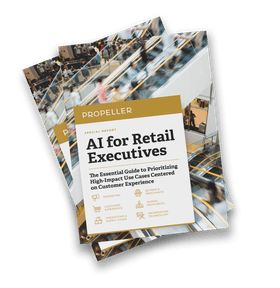As organizations shape and execute their AI strategies, many are forming cross-functional committees to govern and guide AI initiatives. Whether labeled as an AI council, task force, or steering group, these bodies are emerging in response to the fast-moving, unpredictable nature of AI adoption—a journey that often feels like laying down the tracks while the train is already moving.
Yet, while cross-functional committees often signal a thoughtful approach, their structure and remit must align with the scale and ambition of the AI transformation they oversee. When misaligned, they can inadvertently hinder progress.
# Common AI Governance Challenges That Stall Progress
- Functional leaders feel disconnected from the technology strategy and perpetually in reactive mode.
- AI/ML engineers find themselves bogged down by governance processes that seem excessive or unsuitable for their tasks.
- Innovation, though encouraged, spirals into unchecked experimentation, leading to siloed learnings, redundancy, mounting tech debt, and unmanaged legal and brand risks.
These challenges don’t mean governance isn’t necessary, just that it must be intentional.
To avoid these pitfalls, you must first assess the scale and scope of your AI journey. Whether you’re experimenting with narrow use cases or driving enterprise-wide AI transformation, your governance model, including its leadership, remit, and processes, must be purpose-built to match your ambitions.
For a deeper dive into aligning people and processes in AI implementation, read Center People and Processes in Your Next AI Implementation
# Defining the Scale and Scope of Your AI Journey
Before deciding who should be on your cross-functional council (or even determining if you need one), it’s essential to align with company leadership regarding the scale and scope of your AI journey.
Is your company known for pioneering cutting-edge, customer-facing technology? Or do you view AI mainly as a tool to enhance creativity and efficiency but lack the budget or buy-in to reimagine workflows through AI-human collaboration? Perhaps your teams have been experimenting with AI, even building tools in-house, and now it’s time to decide whether to operationalize those ideas internally or take them to market.
For a structured approach to AI planning, explore How to Develop a Winning AI Strategy: A Step-By-Step Guide.
# The Four Paths of AI Adoption
Through our work, we’ve identified four distinct paths organizations take in their AI journey. Each path evolves in its need for cross-functional collaboration, investment, governance, and potential for transformative impact.
1. Aligning
Organizations at this stage are building awareness that AI-driven change is critical to their future. The focus is on identifying behaviors, mindsets, and leadership practices needed to drive adoption. Key Characteristics: Early-stage discussions, leadership alignment on the why behind AI adoption.
2. Evolutionary
Leaders or teams experiment with AI tools or solutions, ensuring alignment with business strategy before making larger investments. The focus is on bringing proven experiments to life. Key Characteristics: Function-specific use cases, moving from testing to scaling AI solutions.
3. Revolutionary
Cross-functional leaders collaborate to combine and scale AI initiatives, generating value greater than the sum of their parts. AI becomes part of day-to-day operations, driving measurable business impact. Key Characteristics: High coordination across teams, operational AI use generating real value.
4. Market Redefining
AI transformation reaches its highest level, reshaping internal operations and customer experiences to create entirely new realities that did not previously exist. These initiatives require significant cross-functional collaboration, governance, and strategic alignment. Key Characteristics: Enterprise-wide AI transformation, innovative, market-leading solutions.
# Scale and Scope Your AI Governance Council
Once you’ve identified the path your company is on, the next step is to align the structure and intensity of your AI governance council with the demands of that journey. Just as you wouldn’t pack the same for a day hike as you would for an international expedition, the design of your council should match the complexity and scope of your AI ambitions.
The best way to determine the right model is to first assess two fundamental dimensions of AI governance:
- Is your focus functional or cross-functional?
- Are you aiming for experimentation or operationalizing AI projects?
Where your organization falls within these dimensions will inform who should be involved in your council, their responsibilities, how frequently you meet, and how progress should be communicated. Use the quadrant below to locate your current position and determine the next steps for structuring AI oversight.

# Navigating the Four Quadrants
Your position among the quadrants allows you to map the appropriate structure of an AI governance council to best support your goals. Each quadrant represents a distinct governance model based on the following dimensions:
- Goal complexity
- Level of cross-functional collaboration
- Legal oversight
- Alignment with technology strategy
Let’s walk through each quadrant, exploring how these four dimensions shape the right AI oversight structure for different stages of AI adoption.
# Targeted Exploration: Lightweight AI Experimentation
If your focus is on testing AI solutions within a single function, you are engaging in Targeted Exploration. This involves a small team of functional subject matter experts (SMEs) addressing a specific, localized need.
- Goal complexity: Low, focused on a single function
- Cross-functional collaboration: Minimal, remains contained within one team
- Legal oversight: Limited given the low-risk nature of these use cases, though legal confirmation is recommended
- Technology strategy alignment: Low, as this experimentation typically operates independently of enterprise-wide goals
Example: A marketing team testing generative AI tools for social media or ad copy creation without broader IT or legal involvement.
AI Governance Council Recommendation: A lightweight, function-specific council with a small number of SMEs to oversee experimentation and provide legal confirmation when needed.
# Collaborative Innovation: Driving Cross-Functional AI Adoption
For organizations looking to move beyond siloed experimentation, Collaborative Innovation encourages cross-functional leaders or executives with the ability to mandate collaboration across teams to explore how AI could transform business functions such as HR, finance, operations, and supply chain. This leads to broader AI opportunities but often lacks structured processes for sharing insights across teams.
- Goal complexity: Moderate, exploring multiple functions
- Cross-functional collaboration: Growing, more AI opportunities are being explored, but processes for sharing insights remain inconsistent and not fully structured
- Legal oversight: Increasing, as experiments touch regulated areas, requiring growing attention to compliance and ethical considerations
- Technology strategy alignment: Flexible to allow for innovation but moving toward strong integration
Example: A finance and HR team collaborating to automate workforce planning using AI-driven predictive analytics.
AI Governance Council Recommendation: A cross-functional council, typically led by a senior business or technology leader—such as a Chief Innovation Officer (CIO) or a designated AI champion—with functional VPs and legal advisors to coordinate experiments, share learnings, and ensure alignment with emerging best practices.
# Isolated Efficiency: Operationalizing AI in a Specific Function
If your goal is to optimize or transform a specific function through operationalizing AI, you are in the Isolated Efficiency quadrant. At this stage, AI is no longer experimental; it is being used at scale within a function, requiring strict compliance, alignment with enterprise systems, and functional expertise. SMEs play a critical role in ensuring AI solutions meet department-specific needs while integrating into enterprise systems.
- Goal complexity: High, focused on functional transformation
- Cross-functional collaboration: Limited to function-specific execution
- Legal oversight: Mandatory, given real-world AI activation
- Technology strategy alignment: High, ensuring seamless integration into enterprise tech ecosystem and avoiding redundancies
Example: An HR team deploying an AI solution to automate resume screening and candidate shortlisting for open roles.
AI Governance Council Recommendation: A function-specific council led by department SMEs with close collaboration from legal and IT teams to ensure compliance and technical alignment.
# Coordinated Transformation: Scaling AI Across the Enterprise
In Coordinated Transformation, AI is embedded enterprise-wide with leadership fully committed to its success. Leaders don’t just approve AI investments, but they actively support ongoing AI R&D, use AI tools themselves, and drive adoption within their teams. As AI solutions scale across functions, the need for robust governance, cross-functional coordination, and strategic alignment becomes critical.
- Goal complexity: Very high, spanning the entire organization
- Cross-functional collaboration: Enterprise-wide coordination
- Legal oversight: Robust governance and compliance required
- Technology strategy alignment: Fully integrated with enterprise tech stack
Customer-facing example: A travel and hospitality company rolling out a personalized virtual concierge chatbot. This requires customer experience, product, engineering, legal, and marketing collaboration to refine chatbot functionality, tone, and use cases. Product teams ensure smooth integration, data science and engineering handle technical deployment, legal advises on guardrails, and marketing ensures the chatbot aligns with brand messaging.
Employee-facing example: A global organization deploying Microsoft Copilot across all departments to enhance productivity and streamline workflows. This AI-powered assistant helps employees with document creation, email responses, and project management within Microsoft 365. Cross-functional teams—including IT, HR, and business units—collaborate on deployment, training, and use-case optimization, while legal oversight ensures compliance with privacy regulations and ethical standards.
AI Governance Council Recommendation: A centralized, enterprise-wide AI governance council typically led by a senior executive, such as a Chief AI Officer (CAIO) or Chief Technology Officer (CTO), with cross-functional leaders, legal, and IT experts to manage governance, strategy alignment, and risk across complex, scaled deployments.

AI for Retail Leaders: Use Case Guide
Learn how leading retailers are using AI to enhance CX, streamline operations, and deliver value.
# Putting It All Together: Mapping Your AI Governance Approach
AI governance is not one-size-fits-all, organizations must align their governance structures with their stage of AI adoption. Whether experimenting in a single function or scaling AI across the enterprise, the right level of cross-functional coordination, legal oversight, and technology alignment will help AI initiatives succeed. The graph below illustrates how these factors shift across four distinct AI adoption quadrants.

The radial map highlights how governance needs evolve as AI adoption scales. Larger, more expansive shapes indicate higher levels of cross-functional collaboration, legal oversight, and alignment with technology strategy at each stage. Understanding your quadrant and where your organization sits within this model can help you design an AI governance approach that meets your organization’s needs.
For companies in Coordinated Transformation, a cross-functional committee is non-negotiable—it ensures alignment, mitigates risks, and drives measurable impact. In other quadrants, while cross-functional collaboration may be less critical, thoughtful design of roles, responsibilities, and communication rhythms will ensure your AI initiatives stay on course.
# Conclusion
At Propeller, we help organizations articulate what AI path they’re on and then operationalize the forums that will help them achieve their goals. Companies rarely remain in one quadrant for long; as AI initiatives scale, oversight needs will evolve. A team testing AI tools today may soon find itself navigating enterprise-wide adoption. By recognizing the unique demands of each quadrant, leaders can anticipate when their AI governance councils need to expand or contract to support their transformation journey.
For insights into keeping AI strategy aligned with business goals as your initiatives scale, check out AI Alignment: Four Strategic Considerations to Maximize Business Value in 2025
AI adoption is not static. It is a dynamic, iterative process. By staying attuned to these levers, leaders can ensure their AI governance structure scales in step with AI’s growing role in their business.





